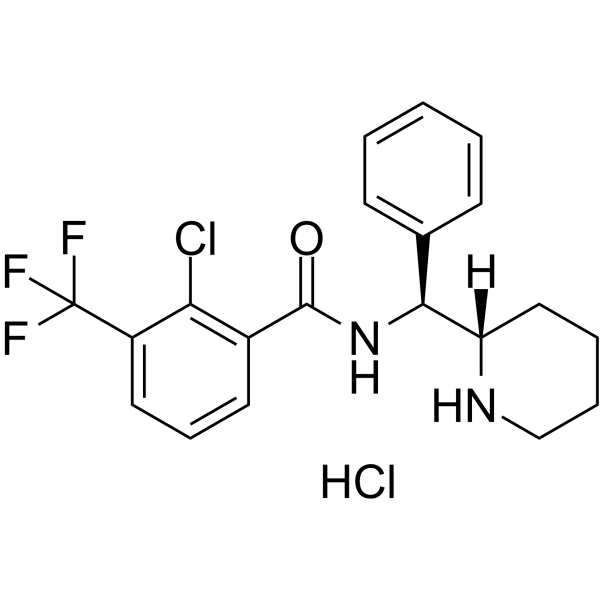2-Chloro-3-(trifluoromethyl)-N-((S)-phenyl((S)-piperidin-2-yl)methyl)benzamide hydrochloride
Modify Date: 2025-08-25 13:21:22

2-Chloro-3-(trifluoromethyl)-N-((S)-phenyl((S)-piperidin-2-yl)methyl)benzamide hydrochloride structure
|
Common Name | 2-Chloro-3-(trifluoromethyl)-N-((S)-phenyl((S)-piperidin-2-yl)methyl)benzamide hydrochloride | ||
|---|---|---|---|---|
| CAS Number | 615571-23-8 | Molecular Weight | 433.29500 | |
| Density | N/A | Boiling Point | N/A | |
| Molecular Formula | C20H21Cl2F3N2O | Melting Point | N/A | |
| MSDS | N/A | Flash Point | N/A | |
Use of 2-Chloro-3-(trifluoromethyl)-N-((S)-phenyl((S)-piperidin-2-yl)methyl)benzamide hydrochlorideSSR504734 is an orally active, selective and reversible inhibitor of human, rat, and mouse GlyT1 (IC50=18, 15, and 38 nM, respectively). SSR504734 shows anti-schizophrenia, anti-anxiety and anti-depression activities[1]. |
| Name | 2-Chloro-N-{(S)-phenyl[(2S)-2-piperidinyl]methyl}-3-(trifluoromet hyl)benzamide hydrochloride (1:1) |
|---|
| Description | SSR504734 is an orally active, selective and reversible inhibitor of human, rat, and mouse GlyT1 (IC50=18, 15, and 38 nM, respectively). SSR504734 shows anti-schizophrenia, anti-anxiety and anti-depression activities[1]. |
|---|---|
| Related Catalog | |
| Target |
hGlyT1:18 nM (IC50) rGlyT1:15 nM (IC50) |
| In Vitro | SSR504734 (15 nM-86 μM; 10 min) inhibits glycine uptake in human SK-N-MC and rat C6 cells[1]. Cell Viability Assay[1] Cell Line: Human neuroblastoma (SK-N-MC) and rat astrocytoma (C6) cells Concentration: 15 nM-86 μM Incubation Time: 10 min Result: Showed IC50 values of 18 and 15 nM for human SK-N-MC and rat C6 cells, respectively. |
| In Vivo | SSR504734 (i.p. and p.o.; 1-100 mg/kg; once) treatment shows good oral bioavailability[1]. SSR504734 (i.p.; 30 mg/kg; once) induces a rapid and significant decrease of specific glycine uptake[1]. SSR504734 (i.p.; 10 mg/kg; once) increases extracellular levels of Glycine in the prefrontal cortex (PFC) of freely moving rats[1]. Animal Model: Male Sprague-Dawley rats[1] Dosage: 1-100 mg/kg Administration: Intraperitoneal injection and oral gavage.; 1-100 mg/kg; once Result: Showed ID50 values of 5.0 and 4.6 mg/kg for i.p. and p.o. treatments, respectively. Animal Model: Male Sprague-Dawley rats[1] Dosage: 30 mg/kg Administration: Intraperitoneal injection; 30 mg/kg; once Result: Maintained at about 80% inhibition from 1 to 7 h after administration. Animal Model: Male Sprague-Dawley rats[1] Dosage: 10 mg/kg Administration: Intraperitoneal injection; 10 mg/kg; once Result: Produced a rapid and sustained increase in PFC extracellular levels of glycine. |
| References |
| Molecular Formula | C20H21Cl2F3N2O |
|---|---|
| Molecular Weight | 433.29500 |
| Exact Mass | 432.09800 |
| PSA | 44.62000 |
| LogP | 6.67760 |
| InChIKey | YGCZZYKACZXKHK-AKXYIILFSA-N |
| SMILES | Cl.O=C(NC(c1ccccc1)C1CCCCN1)c1cccc(C(F)(F)F)c1Cl |